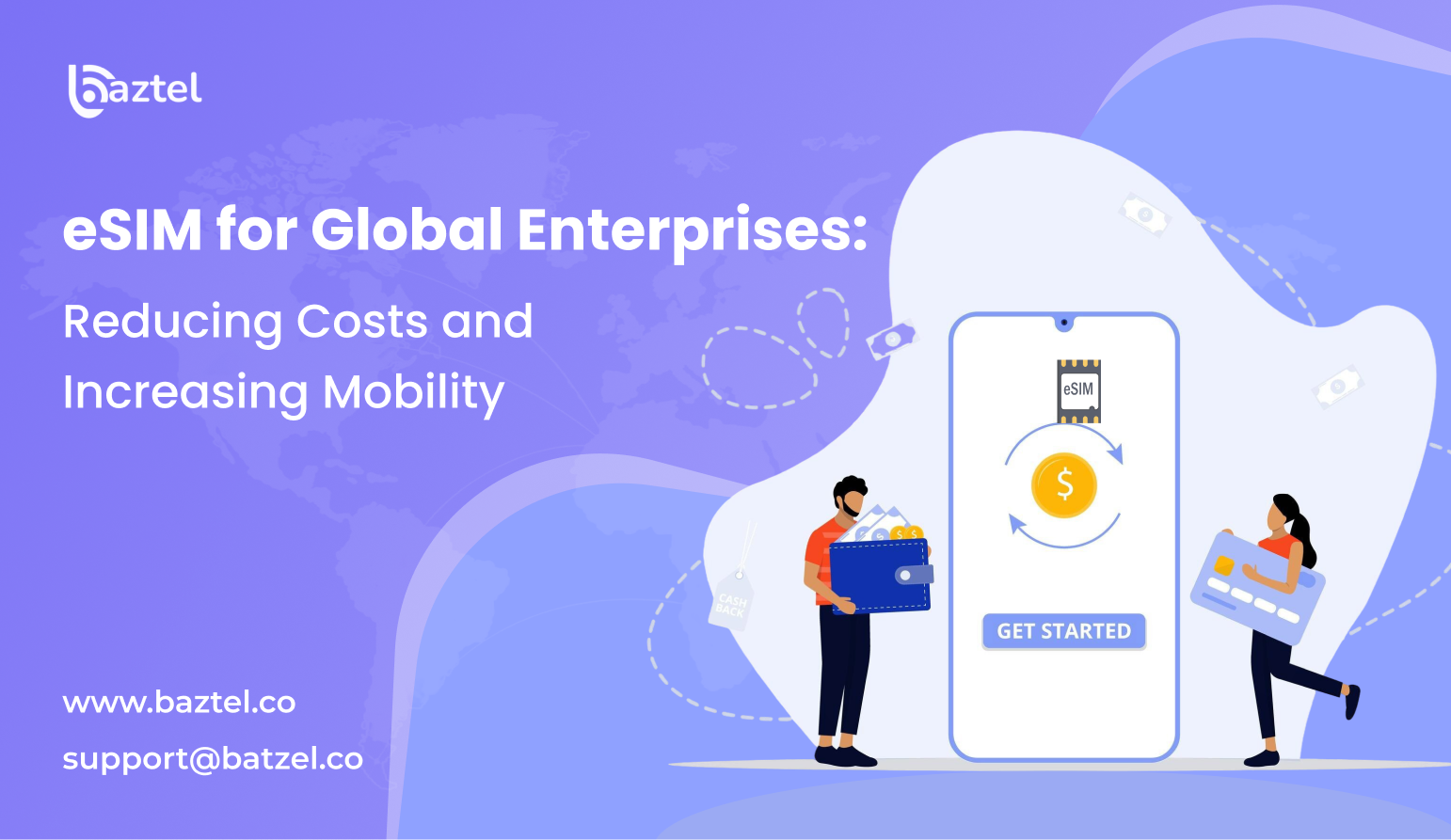Global enterprises depend on smooth communication. Teams are spread across regions, employees travel often, and business devices must stay online without interruptions. Traditional SIM cards make this hard. Buying new SIMs in every country, handling roaming bills, and managing reimbursements create unnecessary costs and delays.
This is where eSIM offers an advantage. It is digital, easy to activate, and fits perfectly into the way enterprises now work. An eSIM can hold multiple profiles and switch networks within seconds. This flexibility not only reduces expenses but also improves mobility for employees.
Companies are already making the shift. As explained in our eSIM for Business guide, the adoption of eSIM is more than convenient. It is a step towards smarter communication systems, tighter security, and better cost control. In this blog, we will focus on how eSIM helps global enterprises reduce costs and give employees the mobility they need.
What Is an eSIM for Enterprises?
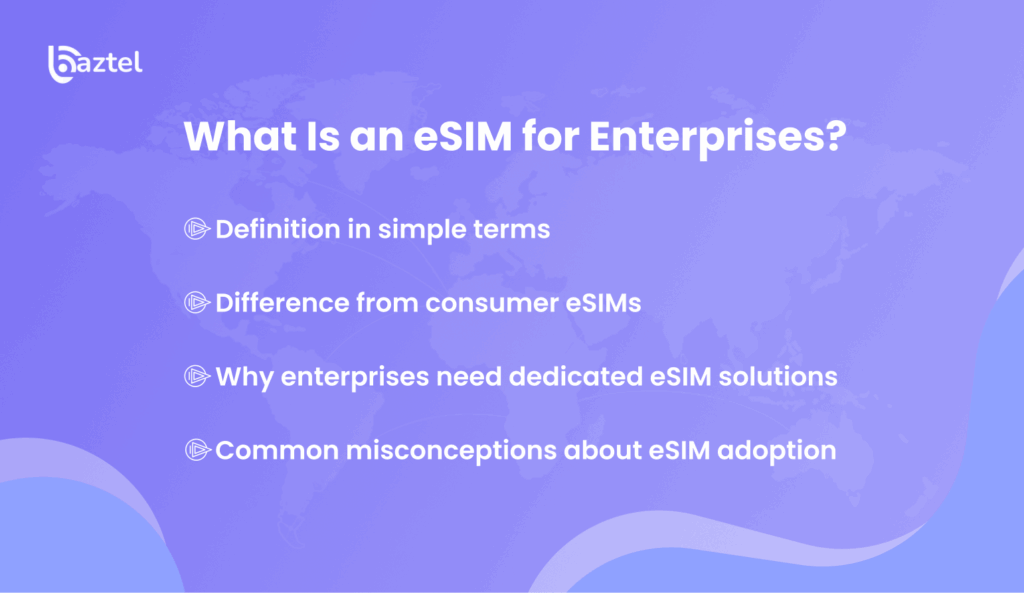
An eSIM for enterprises is a digital version of the SIM card, designed for organizations that manage large teams. Unlike a plastic SIM, it is built into the device and can be activated remotely. Employees do not need to wait for delivery or replace SIM cards when they travel. This makes enterprise mobility faster and easier.
For IT departments, eSIM brings more control. From one dashboard, they can assign plans, switch networks, or deactivate numbers for hundreds of employees at once. This saves time, cuts paperwork, and ensures every device stays connected when needed.
Enterprise eSIMs are also different from consumer eSIMs. While the core technology is the same, business solutions come with extra features such as bulk activation, central billing, and integration with mobile device management tools. These options make it practical for companies with global teams.
Many people still think eSIM is only for travelers. In reality, enterprises now use it for cost savings, employee flexibility, and secure communication. If you are new to the basics, see our guide on what an eSIM is and how it works. It explains the foundation before showing how enterprises can scale the benefits.
Benefits of eSIM for Corporate Teams
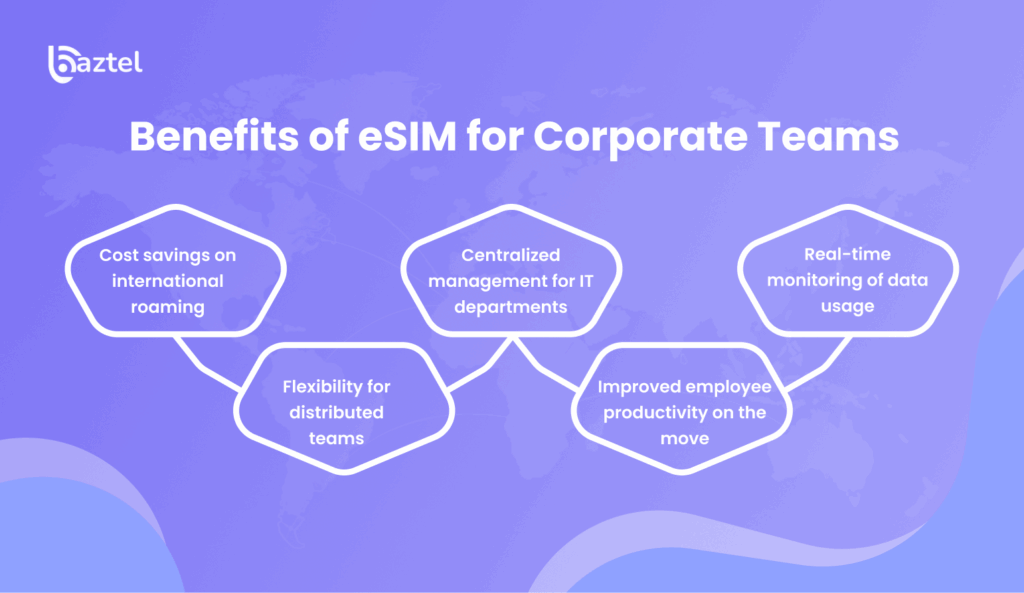
Enterprises with global teams face a common problem: staying connected without draining budgets. Traditional SIM cards require physical distribution, roaming packs, and replacements. eSIM removes these hurdles and gives corporate teams the flexibility to work anywhere.
Cost savings on international roaming
Roaming bills are one of the biggest pain points for companies. With eSIM, employees can switch to local networks in seconds and avoid heavy charges. This makes costs more predictable for finance teams. You can see how travel plans compare in our best eSIM plans for frequent travelers guide.
Improved employee productivity on the move
When employees don’t waste time buying SIM cards or dealing with poor roaming, they can focus on their tasks. This directly boosts productivity and client satisfaction for enterprises.
Real-time monitoring of data usage
Enterprise eSIM platforms come with dashboards that track data use. Managers can see who is consuming more, set alerts, and adjust plans in real time. This avoids surprise bills and keeps spending under control.
No need for multiple SIM cards
Employees no longer carry different SIMs for each country. With an eSIM, they can switch networks right from their phone. This lowers costs and removes the risk of losing or damaging SIM cards during travel.
Transparent billing for travel budgets
Finance teams get a clear view of usage when eSIM is in place. Data use and expenses can be tracked in real time, making travel budgets more predictable. To see how eSIM compares with traditional SIM cards, check our guide on is eSIM better than SIM.
Negotiating enterprise-level data plans
Companies adopting eSIM in bulk can negotiate lower rates with providers. Enterprise data packs bring down per-user costs. For more insights, see our best eSIM plans for frequent travelers.
Avoiding hidden roaming charges
With eSIM, employees activate local profiles instantly. This bypasses roaming charges and keeps monthly bills predictable. Enterprises save more when multiple employees travel often.
Simplifying reimbursements for traveling staff
Employees don’t need to buy SIM cards out of pocket and then file claims. Companies can assign plans directly, cutting paperwork and saving time for both staff and finance teams.
How eSIM Increases Mobility for Global Enterprises
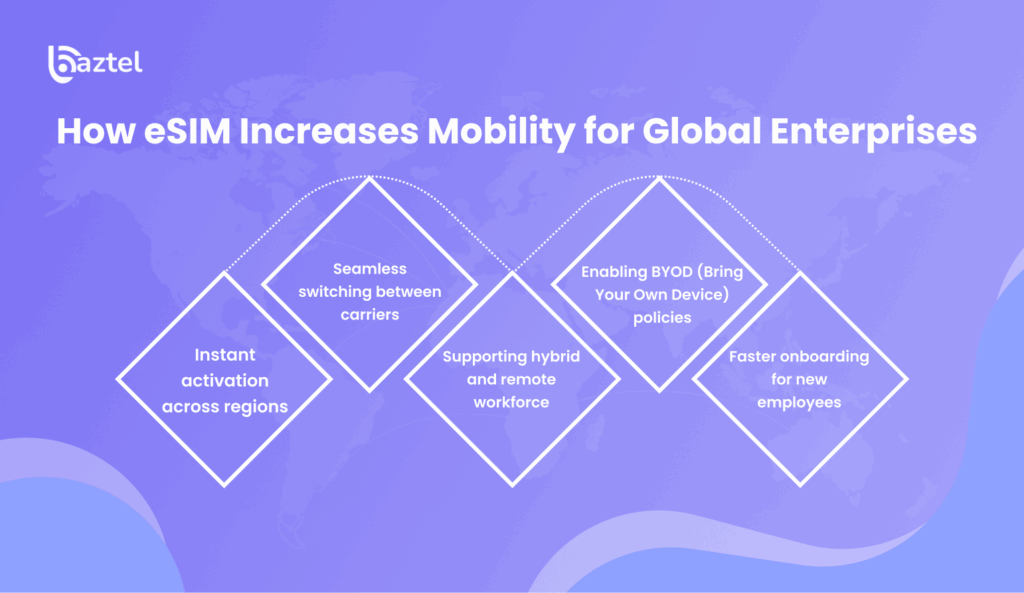
Mobility is at the core of modern enterprises. Employees travel across borders, remote teams log in from different time zones, and business cannot stop for poor connectivity. eSIM gives global enterprises the flexibility to keep everyone online without delay.
Instant activation across regions
With physical SIMs, employees had to wait at airports or depend on courier deliveries. eSIM changes this. Profiles can be scanned and activated within minutes, even before boarding a flight. For a step-by-step view, check our ultimate guide to using eSIM plans for international travel.
Seamless switching between carriers
Coverage gaps are common when teams move between regions. eSIM allows employees to switch networks instantly, ensuring they never miss important calls or meetings while traveling.
Supporting hybrid and remote workforce
With remote work on the rise, enterprises need secure connections for staff working outside the office. eSIM allows employees to connect without relying on public Wi-Fi, keeping communication safe. Our post on ways the global eSIM makes your travels easier highlights how this helps on the go.
Enabling BYOD (Bring Your Own Device) policies
Many companies allow employees to use personal devices for work. eSIM makes this easy by letting IT assign corporate profiles without issuing new SIM cards. Staff can keep personal and work numbers on the same phone.
Faster onboarding for new employees
New hires no longer wait for physical SIMs. eSIM profiles can be activated on day one, making the onboarding process faster and more efficient for enterprises.
Security Advantages of Using eSIM for Enterprises
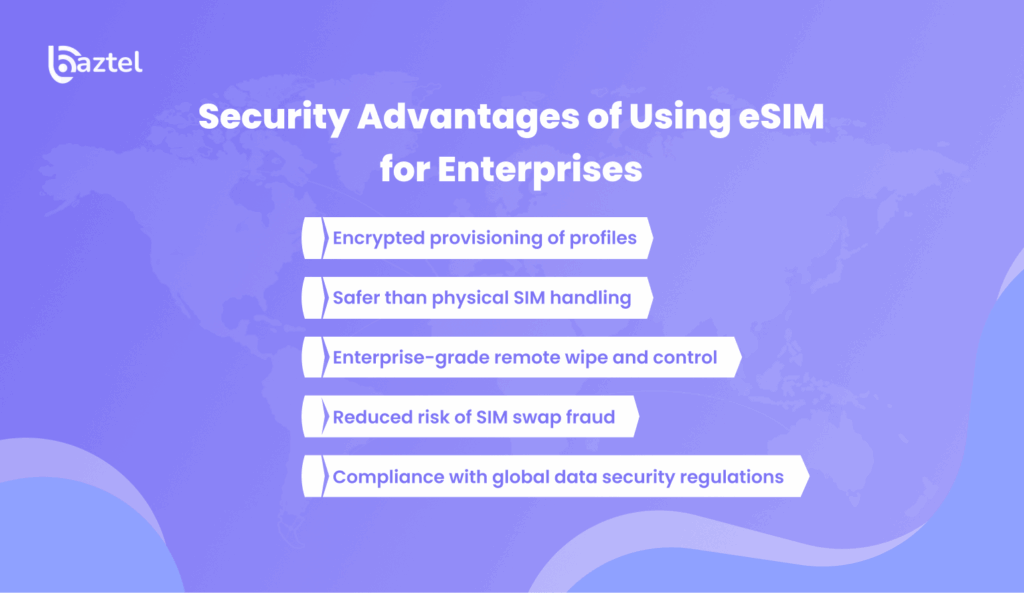
For enterprises, secure communication is just as important as saving costs. Physical SIM cards are easy to lose, clone, or misuse. eSIM technology removes these risks by keeping everything digital and under IT control.
Encrypted provisioning of profiles
Every eSIM profile is delivered with encryption. Only verified devices can use it, reducing the chances of interception or unauthorized access.
Safer than physical SIM handling
Employees no longer exchange or carry multiple SIM cards. This prevents misuse, cloning, and accidental loss. Our eSIM security guide explains why digital profiles are more reliable than plastic cards.
Enterprise-grade remote wipe and control
If a device is lost or stolen, IT managers can disable the eSIM profile instantly. This ensures sensitive company data is not exposed, even outside office networks.
Reduced risk of SIM swap fraud
SIM swap attacks are a rising concern for enterprises. With eSIM, verification is done digitally, making it harder for attackers to hijack corporate numbers linked to financial or login systems.
Compliance with global data security regulations
Enterprise eSIM solutions are designed to meet international security standards. This helps companies operate across regions without breaking data privacy laws.
Managing Corporate Teams With eSIM Technology
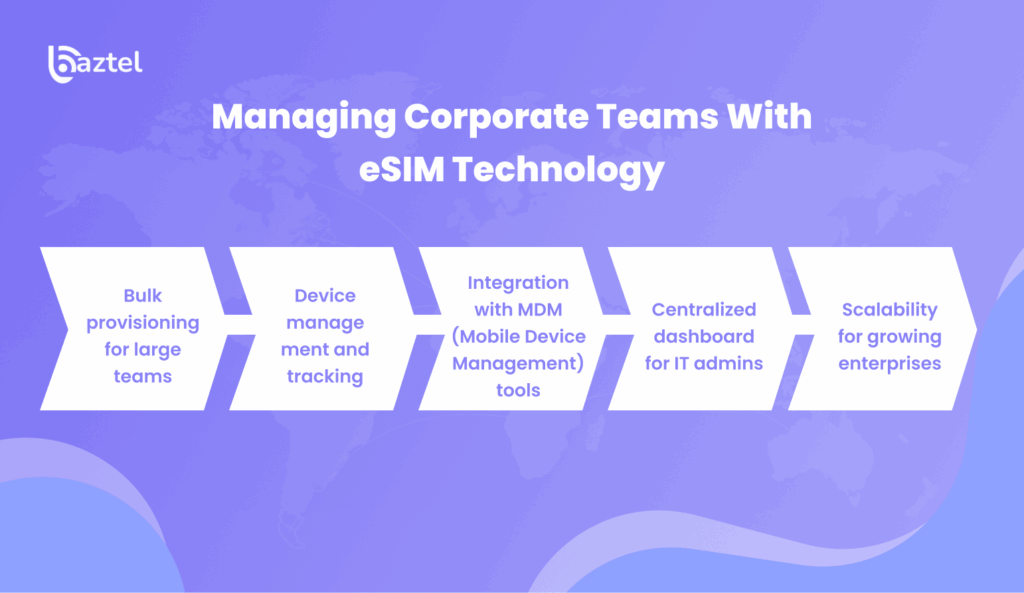
Enterprises need more than individual connections. They need tools that help IT teams manage hundreds of devices at once. eSIM technology gives this control through centralized features built for corporate use.
Bulk provisioning for large teams
Instead of activating SIM cards one by one, IT departments can roll out eSIM profiles to entire teams in a single step. This saves hours of manual work and ensures every employee is ready to connect.
Device management and tracking
With enterprise dashboards, managers can track active devices, monitor usage, and assign plans. This visibility reduces waste and makes sure no employee is left without access.
Integration with MDM (Mobile Device Management) tools
eSIM works well with corporate MDM platforms. IT teams can manage data limits, security policies, and access permissions remotely. If you want to know how employees can update or adjust plans, check our guide on switching between different eSIM plans.
Centralized dashboard for IT admins
One platform gives administrators control over billing, activation, and plan changes. This central system cuts down on errors and makes management simple.
Scalability for growing enterprises
As companies expand into new regions, eSIM makes onboarding new staff easy. IT teams can assign profiles instantly without shipping SIM cards. For setup details, see our guide on setting up eSIM on iPhone and Android devices.
eSIM Use Cases for Global Enterprises
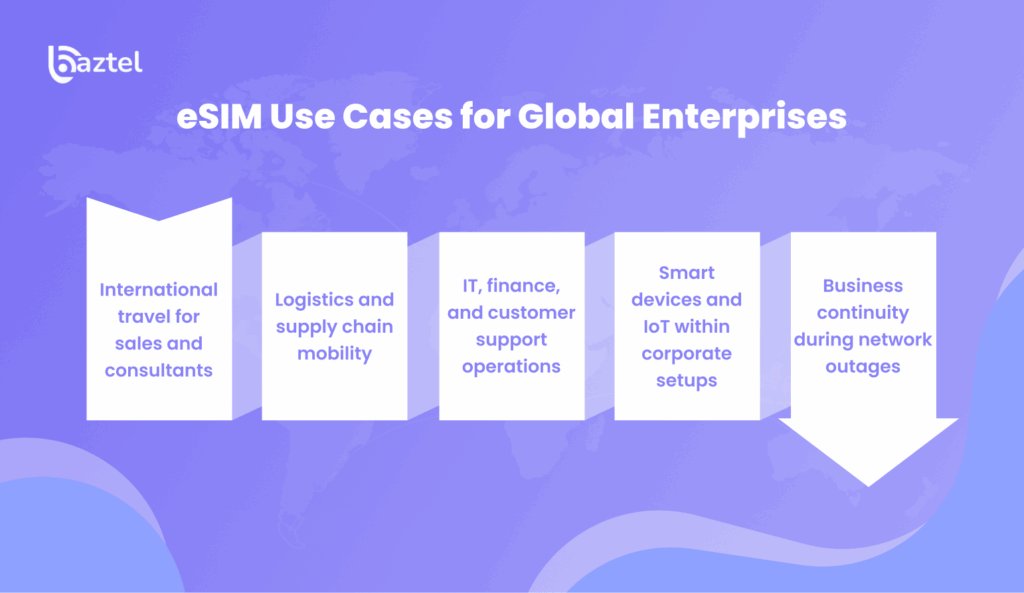
Global enterprises adopt eSIM for more than just travel. It supports day-to-day operations, helps manage costs, and keeps teams connected across industries.
International travel for sales and consultants
Sales teams and consultants often move between countries for client meetings. With eSIM, they can activate local plans before leaving the airport and avoid roaming charges. Our guide on how to use an eSIM for international travel explains how employees can prepare in advance.
Logistics and supply chain mobility
In logistics, real-time updates are critical. eSIM allows drivers, field workers, and warehouse staff to stay connected across borders without waiting for physical SIMs. This reduces downtime and improves delivery accuracy.
IT, finance, and customer support operations
Back-office teams also benefit when enterprises switch to eSIM. Finance, support, and IT staff can handle calls and collaboration tools without relying on weak roaming connections. This helps improve global service quality.
Smart devices and IoT within corporate setups
Enterprises are now connecting IoT devices such as sensors, scanners, and terminals using eSIM. These devices can be updated remotely without manual effort. To compare options, see our best eSIM cards for international trips guide.
Business continuity during network outages
In critical industries, losing connectivity is costly. eSIM enables quick switching between carriers, ensuring operations continue even during network downtime.
Challenges Enterprises Face When Adopting eSIM
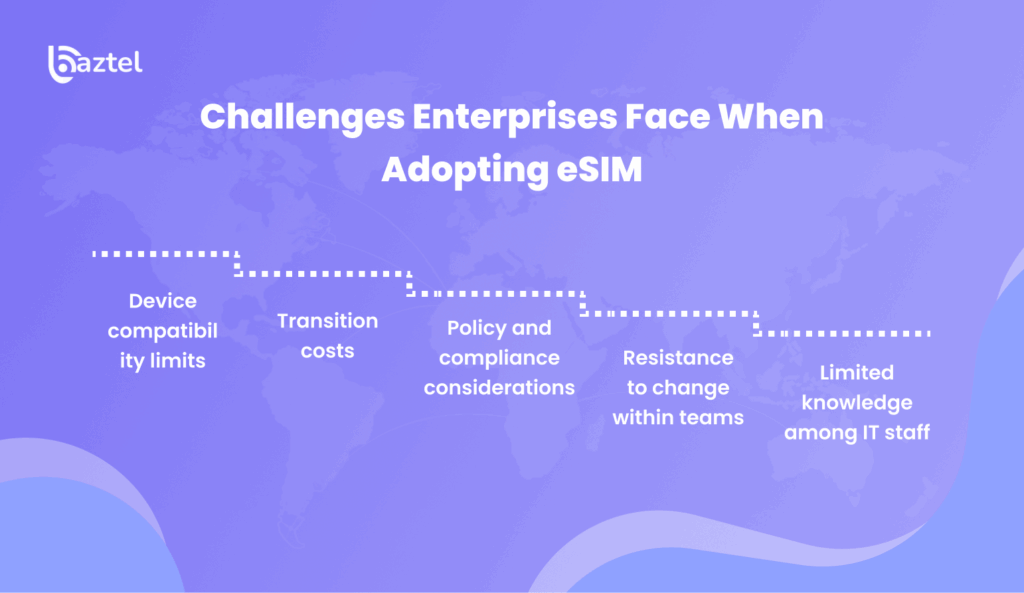
eSIM makes enterprise mobility easier, but rolling it out is not without challenges. Companies need to plan carefully before large-scale adoption.
Device compatibility limits
Not every device supports eSIM. Employees using older models may face issues during setup. Enterprises can avoid delays by checking our eSIM compatibility list before deployment.
Transition costs
Shifting from physical SIM to eSIM requires time and investment. IT teams must handle vendor negotiations, staff training, and migration costs. While savings are clear in the long run, the initial stage demands planning.
Policy and compliance considerations
Enterprises need clear policies for managing profiles, handling billing, and ensuring compliance with regional telecom rules. Without proper governance, usage can be difficult to monitor.
Resistance to change within teams
Employees may be unsure about using eSIM if they are not guided properly. Awareness sessions and step-by-step guides can help staff feel comfortable with the change.
Limited knowledge among IT staff
IT teams may face problems during activation or troubleshooting if they are new to eSIM. Our guide to troubleshooting eSIM issues helps resolve common problems quickly.
Future of eSIM for Enterprises
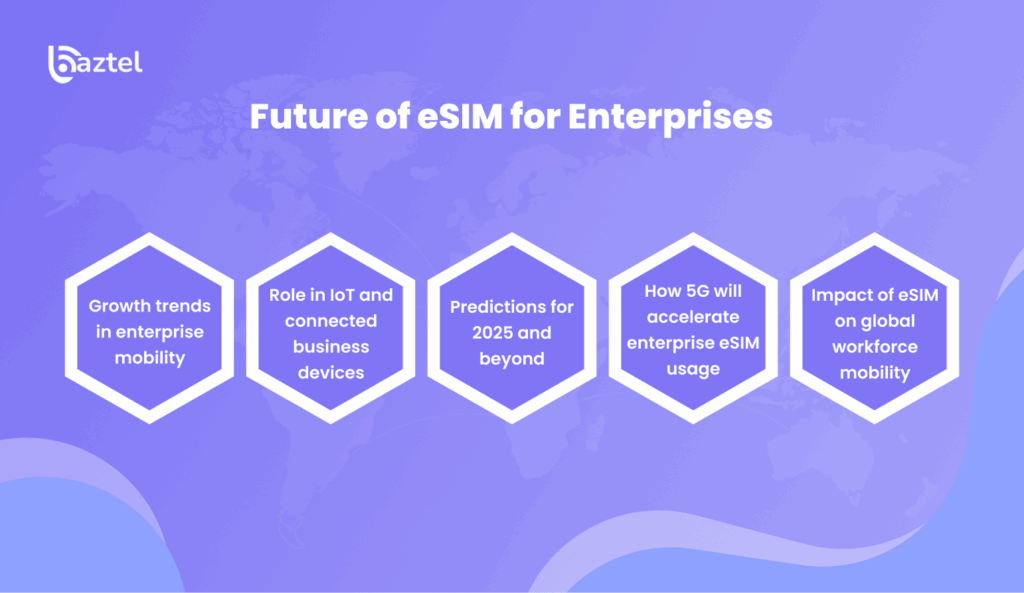
The role of eSIM in enterprises is only going to grow in the coming years. As organizations expand across regions, the need for reliable and flexible connectivity will increase. Traditional SIM cards will not be able to keep up with this demand. eSIM, with its digital-first approach, is already reshaping how companies think about mobility. From enabling secure IoT devices to supporting remote employees, its scope is far beyond cost savings. Businesses that adopt early will be better prepared for the next wave of enterprise mobility. For a deeper look at market shifts, see our future of eSIM analysis.
Growth trends in enterprise mobility
Reports show that more enterprises are planning to switch to eSIM for large-scale communication. Global teams are already using it to reduce roaming costs and improve security. The adoption is expected to rise sharply in industries like IT, consulting, logistics, and finance. As companies continue to move towards digital-first operations, eSIM will become a standard tool for managing mobile connectivity.
Role in IoT and connected business devices
Enterprises are not only using eSIM for phones and tablets but also for IoT devices. Payment machines, scanners, sensors, and even connected vehicles can run on eSIM. This makes it easier to manage thousands of devices from a single dashboard. IT teams can update profiles without physically touching the device. For technical details, our eSIM technology explained guide shows how it works behind the scenes.
Predictions for 2025 and beyond
By 2025, eSIM will become the global standard for enterprises. With the rollout of 5G, the combination of speed and flexibility will transform how teams work abroad. Businesses will see smoother video calls, real-time collaboration, and better device management. Those who adopt now will not just save money but also build a strong foundation for digital operations in the future.
How 5G will accelerate enterprise eSIM usage
5G brings faster connections and more stable networks. When paired with eSIM, it creates a seamless system where employees can switch carriers and regions without losing speed. This is especially important for enterprises running hybrid teams and remote projects. The combination of 5G and eSIM will redefine enterprise communication.
Impact of eSIM on global workforce mobility
As workforces spread out across the globe, enterprises need solutions that keep staff connected at all times. eSIM makes this possible by giving employees the ability to connect instantly in any country. No delays, no roaming worries, just direct access to local networks. For global enterprises, this will be the biggest advantage in supporting a mobile and distributed workforce.
Conclusion: Why Enterprises Should Invest in eSIM Now
Enterprises today cannot afford slow or costly communication systems. Employees travel often, teams are spread across regions, and business depends on fast, reliable connections. Traditional SIM cards create hurdles with roaming costs, physical distribution, and billing complexity. eSIM removes these problems by offering digital profiles that are easy to manage, secure, and flexible. By adopting eSIM for enterprises, companies gain both cost control and mobility advantages.
The shift is not a matter of “if” but “when.” Early adopters will see smoother operations, stronger security, and higher productivity. If your organization is exploring this change, start with our eSIM for Business guide to see how Baztel supports enterprises with global mobility solutions. Acting now will help your business prepare for the future of digital communication.
Frequently Asked Questions (FAQs)
How does eSIM help enterprises reduce costs?
Enterprises spend heavily on roaming charges, SIM card distribution, and reimbursements for employee travel. eSIM reduces these costs by letting employees connect directly to local networks without buying new SIMs. Finance teams can track data use in real time and assign plans based on need, which avoids surprise bills. IT teams also save time by activating or switching profiles from one dashboard. This central control makes enterprise billing clear and predictable.
Can eSIM work for employees using their own devices?
Yes. Many companies follow a Bring Your Own Device (BYOD) policy where employees use personal phones for work. eSIM makes this practical because IT teams can assign a corporate profile without giving physical SIMs. This allows employees to keep personal and work numbers on the same phone. It reduces admin effort and keeps communication secure. Enterprises can also revoke access when an employee leaves, avoiding misuse of company resources.
Is eSIM more secure for corporate teams than physical SIM cards?
Yes. eSIM offers stronger security because profiles are encrypted and cannot be cloned like physical SIMs. Employees do not need to carry or exchange SIM cards, which reduces theft and loss. If a device is stolen, IT managers can remotely disable the eSIM profile and prevent unauthorized access. Our eSIM security guide explains how enterprises benefit from encrypted provisioning, remote wipe, and better fraud protection.
What happens if an employee’s device is not eSIM compatible?
Not all devices support eSIM. Employees with older models may face issues during activation. Enterprises need to check compatibility before rollout to avoid delays. In many cases, staff may need upgraded devices or a mix of eSIM and physical SIM solutions. For accurate details, companies can refer to our eSIM compatibility list. Planning this step early ensures smoother adoption and less confusion among employees during deployment.
Can enterprises use one eSIM plan across multiple employees?
No. Each eSIM profile is tied to a single device. However, enterprises can buy bulk plans and distribute them to employees individually. This way, companies negotiate better pricing with providers while still giving every employee a separate profile. Bulk plans also make billing easier, since all charges appear under one account. Enterprises that manage distributed teams often prefer this model as it combines cost savings with accountability.
How fast can a company deploy eSIM for employees?
Deployment is quick compared to physical SIM cards. Once IT teams generate and share QR codes, employees can activate their eSIM profiles within minutes. This allows enterprises to onboard new hires or prepare staff for business travel instantly. It also removes delays linked to SIM delivery or manual setup. For more details, see our guide on how long it takes to activate eSIM. With proper planning, companies can scale adoption smoothly.
Blog Author
Peter
Peter started BazTel.co to make mobile internet easier for travellers. He noticed how tough it was to find good network options while visiting new countries. That’s when he built BazTel — a place where anyone can buy eSIMs online without confusion or long steps. He believes tech should be simple and useful, not complicated. When he’s free, he likes to travel, test BazTel himself, and keep improving it based on real user problems.

 Botswana
Botswana Zambia
Zambia Congo
Congo Colombia
Colombia China mainland
China mainland Chile
Chile Chad
Chad Central African Republic
Central African Republic Canada
Canada Cameroon
Cameroon Cambodia
Cambodia Burkina Faso
Burkina Faso Bulgaria
Bulgaria Brunei Darussalam
Brunei Darussalam Brazil
Brazil Aland Islands
Aland Islands Bosnia and Herzegovina
Bosnia and Herzegovina Bolivia
Bolivia Belgium
Belgium Belarus
Belarus Bangladesh
Bangladesh Bahrain
Bahrain Azerbaijan
Azerbaijan Austria
Austria Australia
Australia Armenia
Armenia Argentina
Argentina Algeria
Algeria